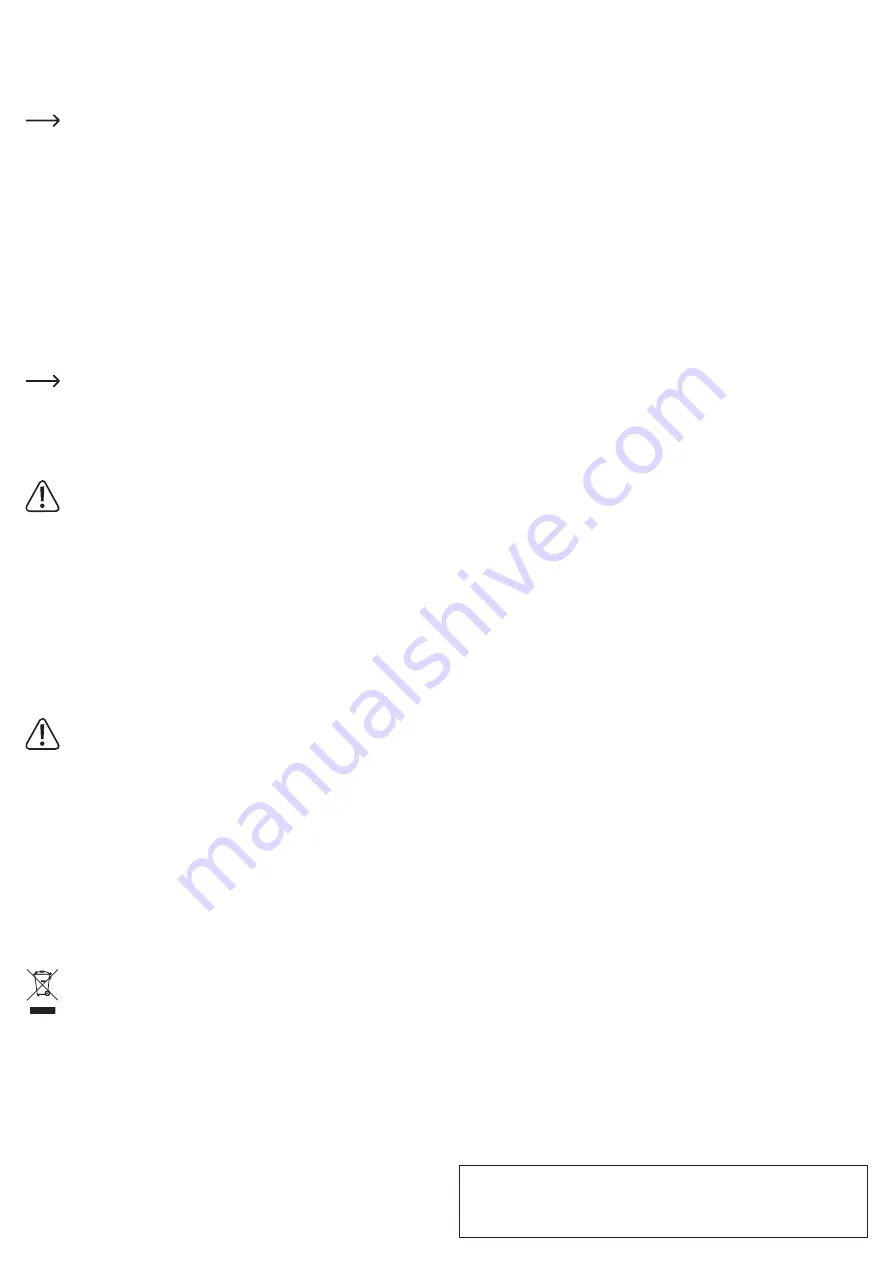
This is a publication by Conrad Electronic SE, Klaus-Conrad-Str. 1, D-92240 Hirschau (www.conrad.com).
All rights including translation reserved. Reproduction by any method (e.g. photocopying, microfilming or capturing in
electronic data processing systems) requires prior written approval from the publisher. Reprinting, also in part, is
prohibited. This publication reflects the technical status at the time of printing.
Copyright 2019 by Conrad Electronic SE.
*1761856_v1_0219_02_hk_m_en
•
Make sure the shut-off valve is open and the knob on the outlet opening provides sufficient
flow of water.
•
After the fountain pump has been placed in sufficiently deep water, connect the mains
plug
(8)
to a mains outlet.
• The fountain pump starts immediately and begins pumping water.
If water is does not pump, it can be indicative of air in the pump. Wait for a few
seconds or remove the mains plug briefly and plug it back in; rock the fountain pump
gently back and forth.
Discontinuing use
Should the fountain pump be taken out of service (e.g. for cleaning, maintenance or storage for
winter), then proceed as follows:
• Disconnect the fountain pump from the power supply, unplug the mains plug from the mains
socket.
• Take the fountain pump out of the water.
• If a hose is attached to the fountain pump, disconnect it from the fountain pump.
• Let the residual water drain out of the fountain pump holding it slantwise.
•
Dry up the fountain pump and the mains cord. If required, clean its outer surface and filter.
Wind up the mains cord.
• In winter, keep the water pump in a dry space protected against frost.
Also do not forget to empty the hoses laid outdoor to avoid frost damages; open
water taps if available.
•
A small quantity of water remains in the fountain pump after use or after the emptying operation.
Therefore, when storing or transporting the pump in a vehicle, use an appropriate mat.
Care and cleaning
When disassembling and reassembling make sure that you put any spacing
washers and bearings back in the same place. Therefore, proceed carefully. Do not
use tools to dismantle and reassemble and do not apply any force.
• Disconnect the product from the mains socket and the connected devices before cleaning
the product.
• Never use aggressive detergents, rubbing alcohol or other chemical solutions, as these may
damage the housing or cause the product to malfunction.
• Use a soft clean cloth to clean the outer surfaces of the fountain pump. If necessary, rinse the
outer surface with clear water.
•
Clean the suction cover
(15)
, filter
(14)
and fountain pump at regular intervals.
• Refer to the drawing in the "Product overview" section. Pull the suction cover off the pump
housing. Remove the pump unit from the filter. Remove the filter from the suction cover.
Clean the filter and the suction cover under running water.
• Only clean the rotor unit
(11)
if the pump is very dirty and does not run properly.
The axis of the rotor unit is made of ceramic and is fragile. It can be easily damaged.
Damage caused by cleaning/removal of the rotor assembly and parts such as the
impeller cover is excluded from the warranty.
• Remove the screw on the impeller cap
(13)
with a Phillips screwdriver. Then, turn the impeller
cap counterclockwise until it releases the impeller cover
(12)
.
•
Pull the impeller cover out to the front. It may be that the impeller cover sits firmly in the
housing, especially after prolonged use. Be careful not to damage the impeller cover when
pulling it out.
•
The rotor unit (impeller with axle) can now be removed carefully. When removing, observe
that the rotor unit is held magnetically. Remember the orientation of all parts. The axis is
fragile. It is made of ceramics. Therefore, pay utmost attention when handling it.
•
Clean the components of the rotor unit from impurities under clean, running water.
• Dry all parts thoroughly and reassemble the pump in reverse order.
Disposal
Electronic devices are recyclable waste and must not be disposed of in the
household waste. At the end of its service life, dispose of the product according to
the relevant statutory regulations.
You thus fulfil your statutory obligations and contribute to environmental protection.
Technical Data
Working voltage ...................................
230 V/AC, 50 Hz
Protection class ................................... I
Protection class of the pump ............... IPX8
Protection class of the mains plug ....... IPX4
Power consumption .............................
58 W
Discharge height ..................................
max. 2.7 m
Immersion depth .................................
max. 3 m
Flow rate ..............................................
max. 2300 l/h
Conveying means temperature
...........
max. +35 ºC
Particle size .........................................
max. 0.5 mm
Hose connection ..................................
G 1/2 inch (12.7 mm)
Mains cable
.........................................
H05RN-F, 3G 0.75 mm
2
/ 10 m length
Operating conditions ............................
0 to +50 °C
Storage conditions ...............................
5 to +40 °C
Dimensions (L x W x H)
.......................
220 x 110 x 430 mm
Weight ................................................. approx. 1.8 kg






























